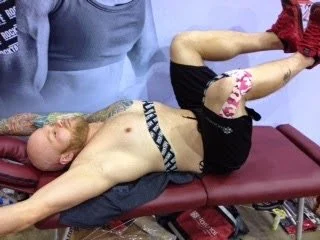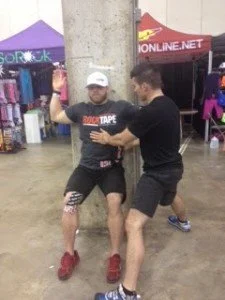Olympic Snatch Lift and Shoulder Stability – Crossfit
Are you efficiently and effectively engaging your diaphragm/core and back muscles?
I evaluate many cross-fitters with the same complaint: “Every time I do my snatch, I get pain in my shoulders… I have scapular instability…. My back kills when I go into a snatch…”
I had the opportunity to work with DJ Downs (Crossfit gym owner and National Sales Representative at Rocktape) who has had the same concern…
I evaluated DJ’s overhead squat (an important aspect of the snatch). I saw his rib’s flaring (chest and ribs coming up), which meant he was not engaging his diaphragm and therefore his core, limiting his stability and power.
DJ also mentioned he was having left shoulder pain during the snatch (which he attributed to a previous injury). His shoulder was in a forward position, putting pressure on his biceps tendon.
A quick chiropractic shoulder adjustment re-centered his shoulder which increased his range of motion took pressure off the bicep tendon – reducing his pain to zero!
Muscle testing his lower trapezius and latissimus dorsi revealed inhibition (lack of optimal recruitment) in both muscles. Both of these muscles are important in the snatch as they provide the majority power and stability in the overhead portion of the snatch lift.
I used my specific way of taping with Rocktape kinesiotape to help activate his lower trap and latissumus dorsi. See Muscle Vector Taping for more info.
Afterwards, I educated DJ on two rehabilitation/stabilization/activation exercises: dead bug march and wall sit angle.
These corrective exercises are designed help with shoulder stability, hip mobility, and core activation. EVERY THING you need in a snatch – and all without putting any strain on his knees, ankles, or back.
By sticking to this regiment for 1-2 weeks, DJ will be able to add weight to the exercise and more efficiently and effectively perform his snatch lift.
“Full of Life!” – Konrad Grzeszkowiak, DC


